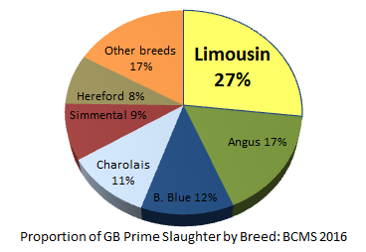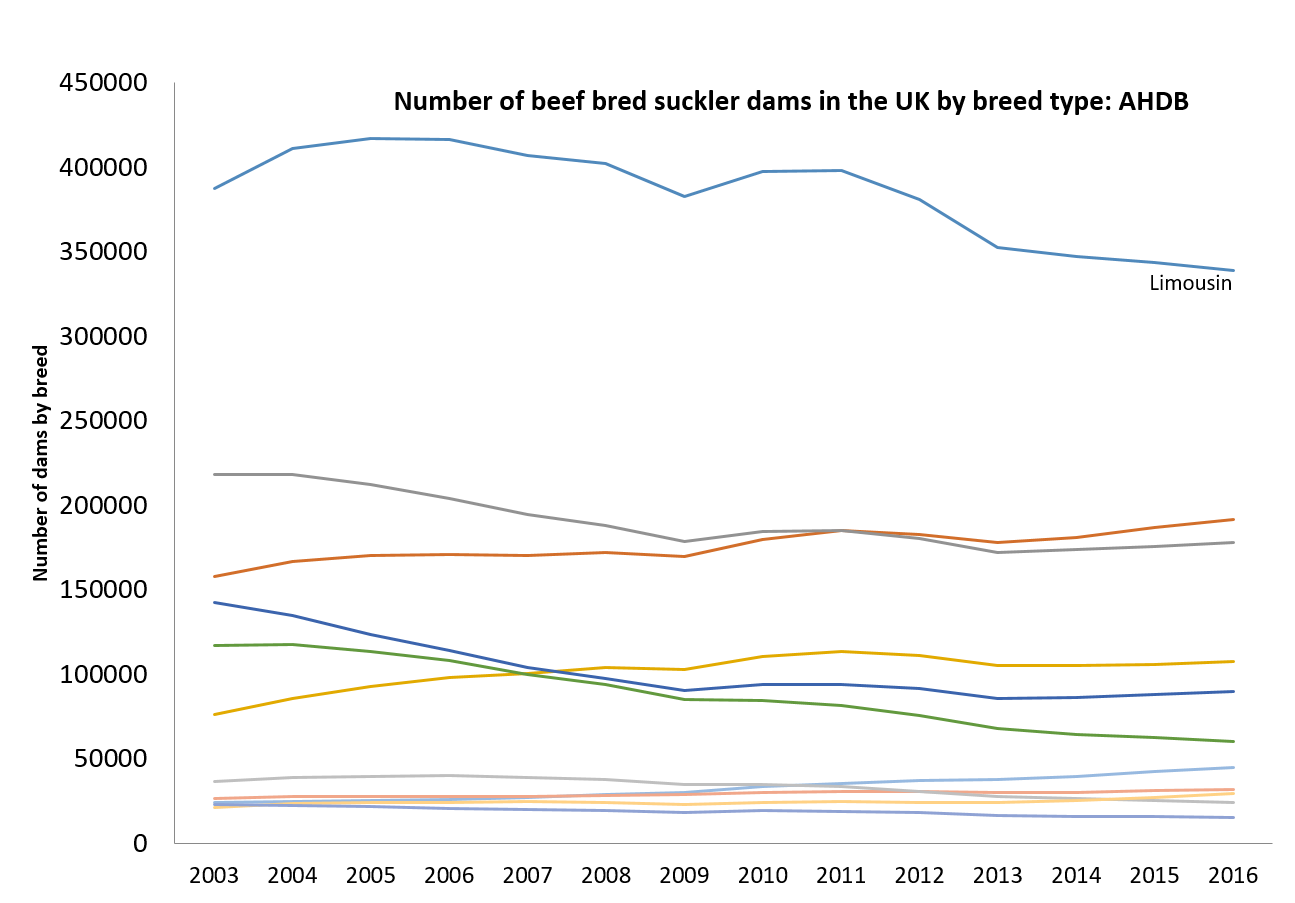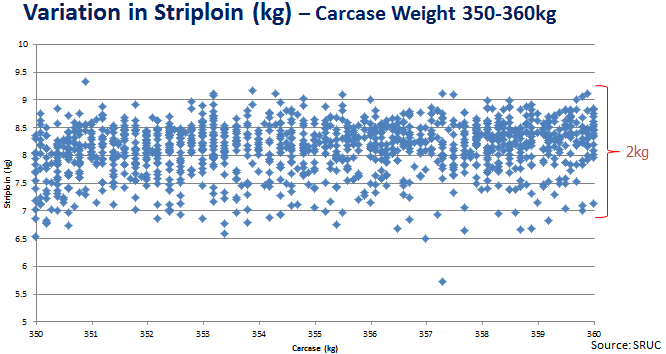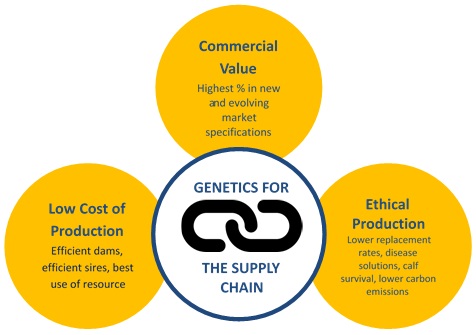Introduction
Over decades, beef breeders and producers have become very proficient at exploiting all management and husbandry resources available to them to maintain and grow their enterprise margins. For many, in comparison with past times, the degree of knowledge, skill, technology and precision deployed to manage successful enterprises has never been greater.
However, across all breeds, our most easily available resource – genetics – has, arguably, not been exploited by industry to quite the same degree as other areas of animal breeding, feeding and management. The consequence of this is it presents an essential and critical resource to exploit at a time when positive margins are becoming increasingly difficult to achieve through good practice alone and at a time when market instability demands rapid response to change.
In 2014, the British Limousin Cattle Society adopted a 10-year Breeding Improvement Plan, representing significant plans for funding and investment. The plan is all about ensuring that users of Limousin cattle capture optimum value from the genetics they are using in ways that haven’t been possible before. As markets change – and they inevitably will – the Society considers it crucial that industry has a breed where the genetics to respond to change and then flourish are identifiable, measured and harnessed.
The value of the research and development work that the Society has engaged in and co-funded is in the region of £3.4million. The following is an overview of that work and the Society’s plans for the future, identifying commercial opportunities and the new streams of income for all beef sectors that are already emerging.
Background
For over 20 years, the Limousin breed has been the single most dominant beef breed in the UK. It accounts for just under one third of all prime cattle slaughterings each year and just under one quarter of all beef-bred suckler cows in the country. The breed has critical mass within the sector; change at genetic level has potential to impact significantly on all parts of the supply chain and the breed improvement work we do is taken seriously and with industry responsibility (Figure 1).
Figure 1

 Source: AHDB/Signet
Source: AHDB/Signet
It is fully recognised by the Society’s council of management that com - mercial sector needs will change over time in terms of markets, pricing structures and the wider trading environment. To this end, in 2014, the Society adopted a Breed Improvement Plan. Following two years of industry consultation and planning, this identifies ten key areas where investment in genetic improvement is desirable and lays out the anticipated approach planned for each.
Figure 2: The 10 goals within the plan.


The planned outcome from this work is the creation of a population of market-relevant genetics that deliver key income opportunities across all supply chain sectors. This will aid the quick delivery of consistent volumes of beef to the market within required specification, however that may change. In turn, this will protect and grow the market share of Limousin genetics, as well as creating new markets and income opportunities for Limousin producers.
As with any investment plan, the Breed Improvement Plan helps prioritise and plan funding from within the Society and from external sources. It identifies where value can be added through integrating areas of work and pooling resources to deliver them. Importantly, it also ensures that all genetic change taking place is desirable and of value to the targeted sector.
The necessary work has commenced and in some cases has been fully delivered. What follows is a summation of the most advanced areas of work, identifying the economic opportunities coming available to the ‘early adopters’ and those who are willingly engaging.
Genomic Breeding Values(GEBVs) for Carcase Traits
This £1.5m, four-year, research project in partnership with SRUC and ABP Food Group ended in 2016. Its aim was to use visual image analysis (VIA) records from selected ABP abattoirs in conjunction with animal DNA and records from BCMS to produce genomic breeding values – the first for the UK beef sector – for:
• Age to Slaughter
• Carcase Weight
• 6 Prime Cuts – fillet, striploin, rump,
topside, silverside and knuckle
Limousin producers and buyers can now select and purchase animals with breeding values for these traits and some 1200 animals have been evaluated in this way since the service was launched. In asking the obvious question ‘why invest in this project?’ some work was undertaken during the project to challenge whether the eventual breeding values would tell us anything about our cattle that we didn’t already know.
Abattoir records from a sample of 20,000 Limousin-bred steers out of dairy herds were examined. Of the 1200 that had similar carcase weights (all were between 350kg and 360kg) and had been allocated the same EUROP grade for conformation, the difference in weight of Striploin was found by VIA to vary on average by approximately 2kg. At a retail value of between £3 –40/kg for striploin, it is not difficult to see that there is value to be captured that is currently undetected (see Figure 3).
Figure 3: Variation in Striploin (kg) – Carcase Weight 350–360kg

When the combined difference between all six cuts was examined, the difference in retail value between the top and bottom thirds of animals – again within the same carcase weight and EUROP grade – was in the region of £150/head. This is added value from genetic difference in our animals that is not yet being captured and exploited fully, but which we now have the means to do so.
On a level arguably leaving more pounds directly in producers’ pockets, the genetic difference between the Top 1% and Bottom 1% animals for Age at Slaughter is 44 days. In other words, animals with Top 1% genetics for Age to Slaughter have the genetic potential to finish 44 days (approx. 6 weeks) faster than those in the Bottom 1% simply by dint of the fact they have inherited faster finishing genetics. A quick back-ofthe-envelope calculation suggests that the faster finished animals could be worth approximately £80 more (44 days at £1.80/day finishing cost) than their slower contemporaries and this is, without doubt, ‘added value from genetics’ at its best.
Genomic Breeding Values for Female Fertility (Maternal) and Calf Survival Traits
The wide use of Limousin as a suckler dam in the UK challenges the breed to continually deliver genetics that produce what it takes to be a productive, efficient, cost effective cow. In 2016, the Limousin Society, along with SRUC, were successful in securing funding to develop new GEBVs for Female Fertility and Calf Survival traits; another first for the beef sector.
The pathway laid out by the Carcase Trait GEBVs provides the platform for these new GEBVs. Calving records collected from all Limousin-bred dams in the country (via BCMS) and animal DNA are combined to produce the breeding values. The research phase was a 12 month project, ending in July, whereupon the GEBVs became available for widespread industry use:
• Age at 1st Calving
• Calving Interval
• Longevity
• Calf Survival
Whilst the breed already has some of these traits available as EBVs, they are typically low accuracy and are based on pedigree records only, generated from within the Society. The breeding information used for the new GEBVs is from the whole of the BCMS dataset, which is considerably larger in volume, producing more accurate results that truly reflect the commercial performance of Limousin-bred cows.
Some interim findings during the earlier research phases in 2016 revealed the nature of the added value to be trapped:
• Limousin has a national replacement rate in the UK that is 5% lower than the next most common type of suckler cow. (This would substantiate the high proportion of the breed in the suckler dam population, referred to earlier)
• Limousin has 2% greater longevity at 8 years of age
• Limousin has 1.5% lower calf mortality in the UK than any other breed
The outcomes of this work will provide opportunity to extend these differences further still. Previous SRUC work has identified advantages in the region of £42pa per cow mated from successful annual calvings.
Estimated Breeding Values for Feed Intake and Feed Efficiency
Limousin is the primary breed in this £1.75m project, co-funded by DEFRA and AHDB. Part way through, its aim is to collect feed intake records over a three year period (ending 2018/19) to produce EBVs for traits associated with feed efficiency. Feed intake recording protocols for the UK will also be established, as will a plan for the ongoing collection of feed intake records beyond the funded stage.
The end point will be that, one year from now, Limousin will have new EBVs that will identify animals with favourable and non-favourable genetics for feed efficiency. Work carried out to date in the UK is suggesting cost saving advantages from feed efficient cattle in the region of £30–40 over a 180-day feeding period, around 20% of the total feed cost. This is in keeping with differences in beef cattle in other countries where such work is well established and, as with other species, there is much to gain from embedding these EBVs in beef breeding programmes.
The plan is taking shape!

It is unrealistic to anticipate that any sector player can capture and exploit all available benefits; the advantage of successfully harnessing any small part will make themselves apparent and will be permanent.
The work completed thus far is already offering income opportunity to those willing and able to adopt it. It has also successfully created a pathway that will enable the roll-out of investmentand activity within the other goal areas of the Breed Improvement Plan. This will ‘futureproof’ the breed’s performance in all sections of the supply chain and ensure that when market change comes, producers have the means and the genetics to quickly and successfully respond. Key to this will be working with partners in the wider beef sectors.
